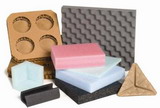Indonesia Packaging Industry Discussed in New Cutting-Edge Report Published at MarketPublishers.com
21 Dec 2011 • by Natalie Aster

LONDON – The Indonesian packaging industry reached USD 7.5 billion in 2011, growing at a CAGR of 4.4% from 2007. Its largest end user – food and beverage sector – accounted for 67% of the total market value in 2011, and is expected to drive the packaging industry growth. While Jakarta has a large demand for Indonesian food products, the country’s main food processing activity is concentrated around Java. Forecasts say the Indonesian packaging industry is expected to register a higher CAGR of 5.1% from 2012 through 2016, to approach a value of USD 9.6 billion by 2016.
Last year, paper and board packaging valued USD 1.85 billion, amounting to 25% of the total Indonesian packaging industry. Rigid plastic is currently the largest packaging category in the country, with a current value of USD 1.88 billion.
New market research report “Packaging Industry Outlook in Indonesia: Market Size, Key Trends, Drivers, and Challenges to 2016” developed by BRICdata has been recently published by Market Publishers Ltd.
Report Details:
Title: Packaging Industry Outlook in Indonesia: Market Size, Key Trends, Drivers, and Challenges to 2016
Published: December, 2011
Pages: 63
Price: US$ 1,950
The report provides true and unbiased insights into the packaging industry in Indonesia. In particular, the study covers:
- historical values (2007–2011) and forecast figures (2012–2016) for the Indonesian packaging industry;
- detailed analysis of the key industry categories, along with market forecasts until 2016;
- details on the different macroeconomic factors affecting the packaging industry in Indonesia;
- exhaustive summary of the key trends and drivers affecting end-user markets in packaging;
- Porter’s five forces analysis of all individual categories and the overall packaging industry;
- overview of the current regulatory framework in the industry.
Report Contents:
1 Executive Summary
2 Future Growth Potential of Packaging in Indonesia
2.1 Indonesian Packaging Industry Overview
2.2 Indonesian Packaging Industry Future Outlook
2.3 Indonesian Packaging Material Size
2.4 Indonesia Packaging Material Market Size by Category
2.4.1 Paper and board packaging
2.4.2 Flexible plastic packaging
2.4.3 Rigid plastic packaging
2.4.4 Metal packaging
2.4.5 Glass packaging
2.5 Indonesia Packaging Machinery Market Size
3 Indonesian Packaging Industry Benchmarking
3.1 Ranking Against Global Packaging Markets
3.2 Global Packaging Market Growth Potential
3.3 Market Share in Paper and Board Packaging
3.4 Market Share in Flexible Plastic
3.5 Market Share in Rigid Plastic
3.6 Market Share in Metal Packaging
3.7 Market Share in Glass Packaging
4 Market Environment, Growth Drivers and Challenges
4.1 Macroeconomic Factors
4.1.1 GDP growth
4.1.2 Annual Disposable Income
4.1.3 Inflation rate
4.2 Regulatory Environment
4.3 Key End-User Market Drivers
4.3.1 End user market growth
4.3.2 Food and beverage market
4.3.3 Pharmaceutical market
4.4 Emerging Business Strategy Trends
4.4.1 New food contact packaging legislation in 2007
4.4.2 Strong growth in flexible plastic packaging to attract investment
4.5 Key Challenges
4.5.1 Competition from cheap ASEAN imports
4.5.2 Indonesia's unattractiveness as an investment destination
5 Indonesian Packaging Trade Dynamics
5.1 Trade Dynamics - Overview
5.2 Packaging Import-Export: Segment Analysis
5.2.1 Paper and board packaging
5.2.2 Rigid and flexible plastic packaging
5.2.3 Aluminum packaging
5.2.4 Glass packaging
5.2.5 Packaging machinery
6 Industry Structure and Competitive Landscape
6.1 Competitive Landscape: Overview
6.1.1 Local companies dominate Indonesian packaging industry
6.2 Industry Dynamics: Five Forces Analysis
6.3 Five Forces Analysis: Paper and Board
6.3.1 Bargaining power of supplier: high
6.3.2 Bargaining power of buyer: medium
6.3.3 Barriers to entry: medium
6.3.4 Intensity of rivalry: high
6.3.5 Threat of substitution: low to medium
6.4 Five Forces Analysis: Flexible Plastic
6.4.1 Bargaining power of supplier: medium
6.4.2 Bargaining power of buyer: medium
6.4.3 Barriers to entry: low
6.4.4 Intensity of rivalry: high
6.4.5 Threat of substitution: low
6.5 Five Forces Analysis: Rigid Plastic
6.5.1 Bargaining power of supplier: high
6.5.2 Bargaining power of buyer: medium to high
6.5.3 Barriers to entry: medium
6.5.4 Intensity of rivalry: medium
6.5.5 Threat of substitution: medium
6.6 Five Forces Analysis: Metal Packaging
6.6.1 Bargaining power of supplier: medium
6.6.2 Bargaining power of buyer: medium
6.6.3 Barriers to entry: medium
6.6.4 Intensity of rivalry: high
6.6.5 Threat of substitution: medium to high
6.7 Five Forces Analysis: Glass
6.7.1 Bargaining power of supplier: medium
6.7.2 Bargaining power of buyer: medium to high
6.7.3 Barrier to entry: low to medium
6.7.4 Intensity of rivalry: high
6.7.5 Threat of substitution: medium
7 Appendix
7.1 About BRICdata
7.2 Methodology
7.3 Definitions
7.4 Disclaimer
List of Tables
List of Figures
More new market research reports by the publisher can be found at BRICdata page.
CONTACTS
The Market Publishers, Ltd.
Tanya Rezler
Tel: +44 208 144 6009
Fax: +44 207 900 3970
Analytics & News
